Spring Boot 连接连接LDAP的方法的方法
主要介绍了Spring Boot 连接LDAP的方法,仅仅涉及基本的使用ODM来快速实现LDAP增删改查操作。具有一定的参考价值,
有兴趣的可以了解一下
本文是Spring Boot系列文集中关于LDAP连接相关操作的一文。仅仅涉及基本的使用ODM来快速实现LDAP增删改查操作。详细的关于
Spring LDAP的其他操作,可以参考翻译的官方文档。
本文目的:使用Spring Boot构建项目,帮助读者快速配置并使用Spring LDAP操作LDAP。大致步骤如下:
1.创建Spring Boot项目(约1分钟)
2.添加pom.xml文件中Spring LDAP依赖(约1分钟)
3.配置Spring LDAP连接信息(约1分钟)
4.创建实体类作为LDAP中的entry映射(ODM映射功能,类似ORM)
5.使用ldapTemplate书写service层的方法(约3分钟)
6.编写controller层(约3分钟)
1.创建创建Spring Boot项目(约
项目(约1分钟)分钟)
IDEA中点击file - new - project
如上图,选择左侧的 Spring Initializr帮助初始化spring项目,配置好SDK后,点击next。
图1
图2
�
点击后,如图2,如果只是做demo,该页面默认即可,点击next。
如图3,我们选择web,右侧会显示web相关的组件,我们选择右侧中的Web,将其前面的框勾选上。这代表在创建的spring boot项目中会
引入web相关的依赖。点击next。
图3
如图4,这里自己命名即可,点击finish。
2.添加添加pom.xml文件中文件中Spring LDAP依赖(约
依赖(约1分钟)分钟)
图4
�
如上图图5,在项目中双击pom.xml来添加依赖。
图5
图6
如图6所示,文件中已经加载了spring-boot-starter-web依赖,我们要使用Spring LDAP来操作LDAP服务器需要添加spring-boot-starter-data-
ldap。该依赖会自动加载spring-ldap-core 与 spring-data-ldap依赖。其中spring-ldap-core是ldap操作的核心依赖,而spring-data-ldap提供了
ODM的功能,能够简化操作。我们可以在项目的External Libraries中看到这两个依赖,如下图图7中三个黄色高亮处:
3.配置配置Spring LDAP连接信息
连接信息
图7
图8
如上图图8,根据spring boot官网对ldap配置的说明来配置,可以看这里。这样配置之后,spring boot会自动读取该配置。
�
4.创建实体类作为
创建实体类作为LDAP中的中的entry映射映射
本例中使用ODM功能,极大的简化了LDAP的操作,关于ODM更多的信息,可以参考翻译的官方文档。
我们在项目中创建如下结构:
现在,我们在entry包下写与entry互相映射的实体类。其中,我的LDAP结构如下
图9
图10
新建Person类
package com.example.demo.entry;
import com.fasterxml.jackson.annotation.JsonIgnore;
import org.springframework.ldap.odm.annotations.Attribute;
import org.springframework.ldap.odm.annotations.Entry;
import org.springframework.ldap.odm.annotations.Id;
import org.springframework.ldap.support.LdapNameBuilder;
import javax.naming.Name;
/**
* @Author: geng_pool
* @Description:
* @Date: Created in 2017/12/27 10:24
* @Modified by:
*/
@Entry(objectClasses = {"organizationalPerson","person","top"},base = "o=myorg")
public class Person {
@Id
@JsonIgnore
private Name dn;
@Attribute(name="cn")
private String cn;
@Attribute(name="sn")
private String sn;
@Attribute(name="userPassword")
private String userPassword;
public Person(String cn) {
Name dn = LdapNameBuilder.newInstance()
.add("o", "myorg")
.add("cn", cn)
.build();
this.dn = dn;
}
public Person(){}
�
/* getter */
public Name getDn() {
return dn;
}
public String getCn() {
return cn;
}
public String getSn() {
return sn;
}
public String getUserPassword() {
return userPassword;
}
/* setter */
public void setDn(Name dn) {
this.dn = dn;
}
public void setCn(String cn) {
this.cn = cn;
if(this.dn==null){
Name dn = LdapNameBuilder.newInstance()
.add("o", "myorg")
.add("cn", cn)
.build();
this.dn = dn;
}
}
public void setSn(String sn) {
this.sn = sn;
}
public void setUserPassword(String userPassword) {
this.userPassword = userPassword;
}
@Override
public String toString() {
return "Person{" +
"dn=" + dn.toString() +
", cn='" + cn + '\'' +
", sn='" + sn + '\'' +
", userPassword='" + userPassword + '\'' +
'}';
}
}
注意@Entry与@Id为必须的。而@JsonIgnore是为了将person传给前端时不报错,因为Name类型的无法自动解析成json格式。注意我为了
方便,在 public Person(String cn) {}构造方法中写上了DN值的生成方法,在setCn中也写上了该方法,当然存在代码重复问题,忽略就好。
5.使用使用ldapTemplate书写书写service层的方法
层的方法
在service包中,新建OdmPersonRepo类
package com.example.demo.service;
import com.example.demo.entry.Person;
import org.springframework.beans.factory.annotation.Autowired;
import org.springframework.ldap.core.LdapTemplate;
import org.springframework.stereotype.Service;
import static org.springframework.ldap.query.LdapQueryBuilder.query;
/**
* @Author: geng_pool
* @Description:
* @Date: Created in 2017/12/27 10:37
* @Modified by:
*/
@Service
public class OdmPersonRepo {
@Autowired
private LdapTemplate ldapTemplate;
public Person create(Person person){
ldapTemplate.create(person);
return person;
}
public Person findByCn(String cn){
return ldapTemplate.findOne(query().where("cn").is(cn),Person.class);
}
public Person modifyPerson(Person person){
ldapTemplate.update(person);
�
return person;
}
public void deletePerson(Person person){
ldapTemplate.delete(person);
}
}
可以看到,基本的增删改查操作都帮我们实现了,我们只要调用一下ldapTemplate中的方法即可。若要更自由的操作ldap的增删改查,可参
阅翻译的官方文档。
6.编写编写controller层层
在controller包下,新建一个testController类来测试LDAP的操作。
package com.example.demo.controller;
import com.example.demo.entry.Person;
import com.example.demo.service.OdmPersonRepo;
import org.springframework.beans.factory.annotation.Autowired;
import org.springframework.ldap.core.LdapTemplate;
import org.springframework.web.bind.annotation.*;
/**
* @Author: geng_pool
* @Description:
* @Date: Created in 2017/12/27 10:50
* @Modified by:
*/
@RestController
public class testController {
@Autowired
private OdmPersonRepo odmPersonRepo;
@RequestMapping(value = "/findOne",method = RequestMethod.POST)
public Person findByCn(@RequestParam(name = "cn",required = true) String cn){
return odmPersonRepo.findByCn(cn);
}
@PostMapping(value = "/create")
public Person create(@RequestParam(name = "cn") String cn,@RequestParam(name = "sn") String sn,@RequestParam(name = "userPassword") String userPassworld){
Person person = new Person();
person.setCn(cn);
person.setSn(sn);
person.setUserPassword(userPassworld);
return odmPersonRepo.create(person);
}
@PostMapping(value = "/update")
public Person update(@RequestParam(name = "cn") String cn,@RequestParam(name = "sn") String sn,@RequestParam(name = "userPassword") String userPassworld){
Person person = new Person();
person.setCn(cn);
person.setSn(sn);
person.setUserPassword(userPassworld);
return odmPersonRepo.modifyPerson(person);
}
@PostMapping(value = "/delete")
public void delete(@RequestParam(name = "cn")String cn){
Person person = new Person();
person.setCn(cn);
odmPersonRepo.deletePerson(person);
}
}
至此,一个基本的demo完成啦。下面我们测试一下
测试测试
为了大家都能跟着步骤来,我就不使用Postman来测试,而是在浏览器中测试接口。、
启动spring boot,没有报错的话,打开浏览器到 localhost:8080/ ,按下F12,弹出开发者模式,找到console控制台方便我们发送测试语句。
首先,引入jquery.js。打开jquery.js,全选-复制-在console中粘贴-回车,如下图:
显示为true,代表加载成功,我们可以使用jquery的ajax来测试了。
图11
�
新增数据
新增数据
正如controller层的testController要求的那样,我们在地址 /create 上使用post方法,将数据cn sn userPassword传过去
图12
而在LDAP服务器中,也显示了新增的数据
查找数据
查找数据
也能根据cn正确查找到数据。
修改数据
修改数据
我们查看LDAP中是否修改
图13
图14
图15
图16
�
可以看到能够正常修改数据
删除数据
删除数据
查看LDAP中是否删除
可以看到,数据被正确删除了。
其他说明
图17
图18
图19
1. 刚才的例子中,代码有需要完善的地方,但对于demo演示来说完全可以忍受。大家可能也看到了这么做也有些缺点,我在update的时
候,需要将修改后的person的所有属性值都传到后台来(这也不算啥缺点,关系数据库的更新也是这样),并且不能修改cn的值(这就
是为什么其他例子中都是使用uid来作为dn的一部分,类似于关系数据库的主键的作用),因为修改后该entry的dn值就变化了,ODM就
无法确定更新哪个数据。会报 javax.naming.NameNotFoundException: [LDAP: error code 32 - No Such Object] 错误。
2. 删除操作也像关系数据库的操作一样,直接给cn即可,这是因为我们在person类中setCn()方法内写了dn的生成函数,这样ODM才能
根据被@Id所注释的dn来找到LDAP中的entry并执行删除操作。
3. 我们在Person类中写了Name类型的dn值的构建方法,但是我一开始按照官网的代码来写,总是出问题,在stackOverFlow中找到了答
案。链接在这里。
4. 想要更深入的了解,可以参考翻译的官方文档。了解更自由更个性化的操作。
以上就是本文的全部内容,希望对大家的学习有所帮助,也希望大家多多支持我们。
�

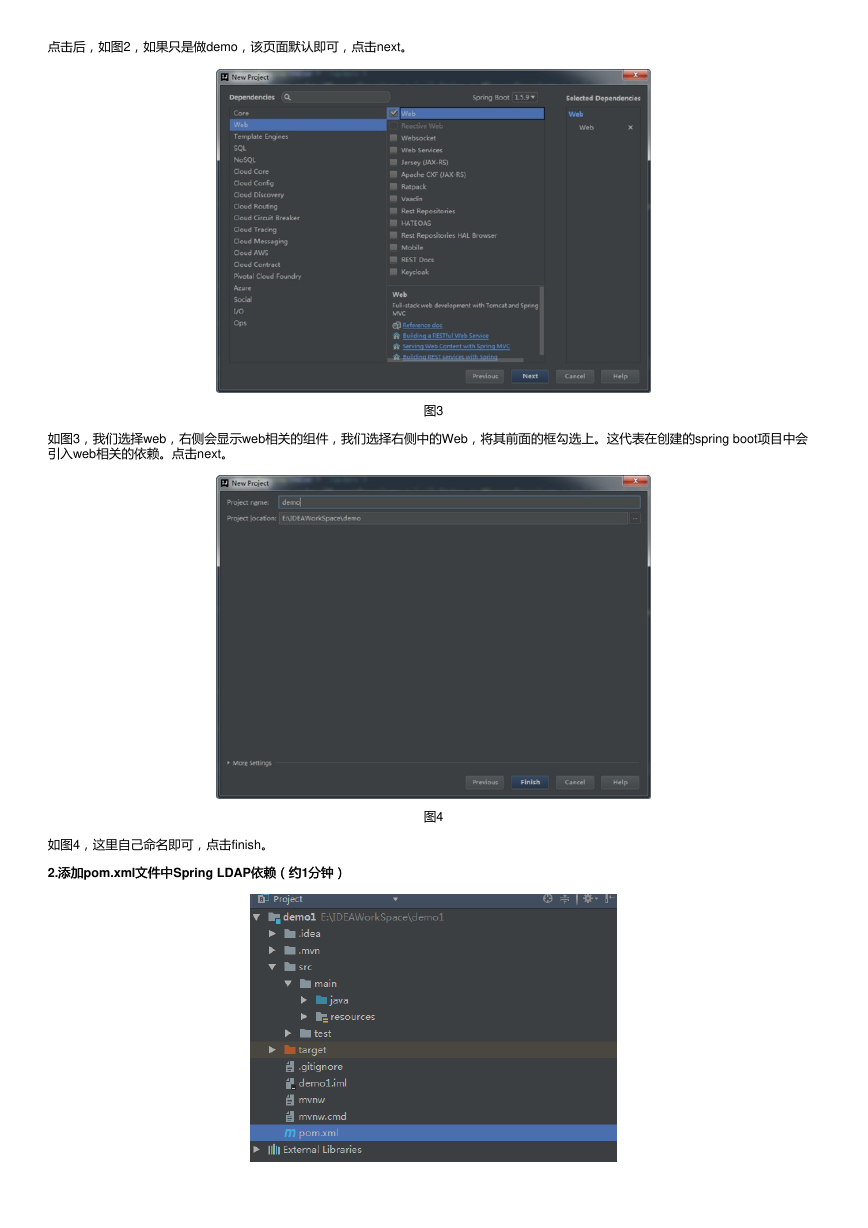
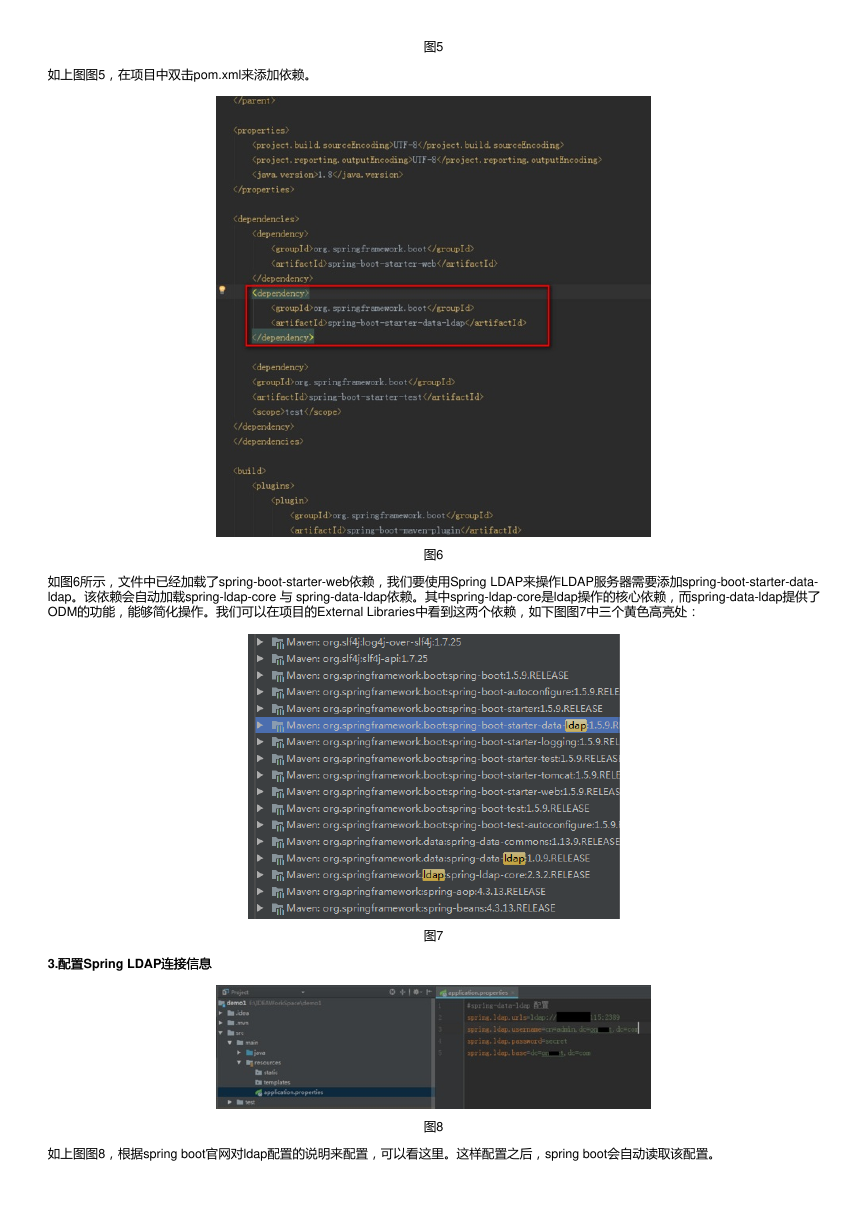
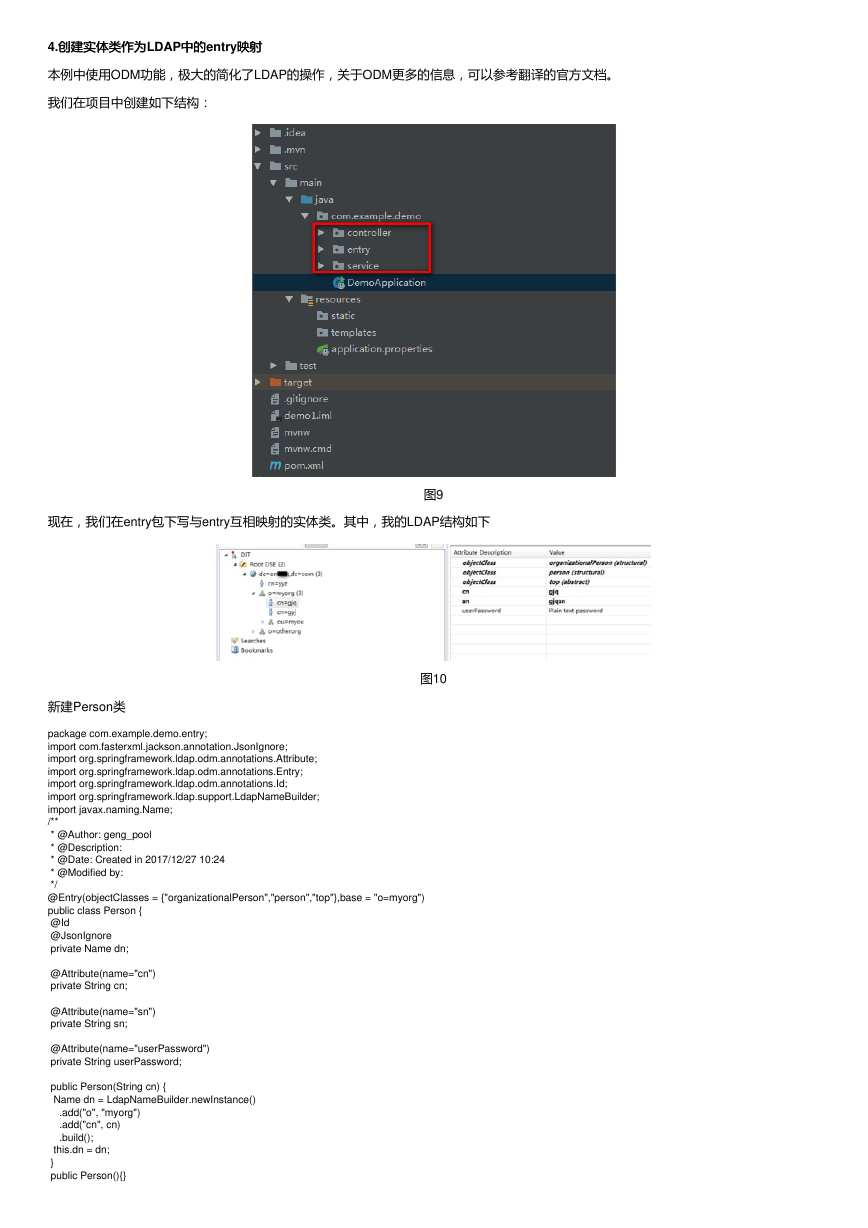
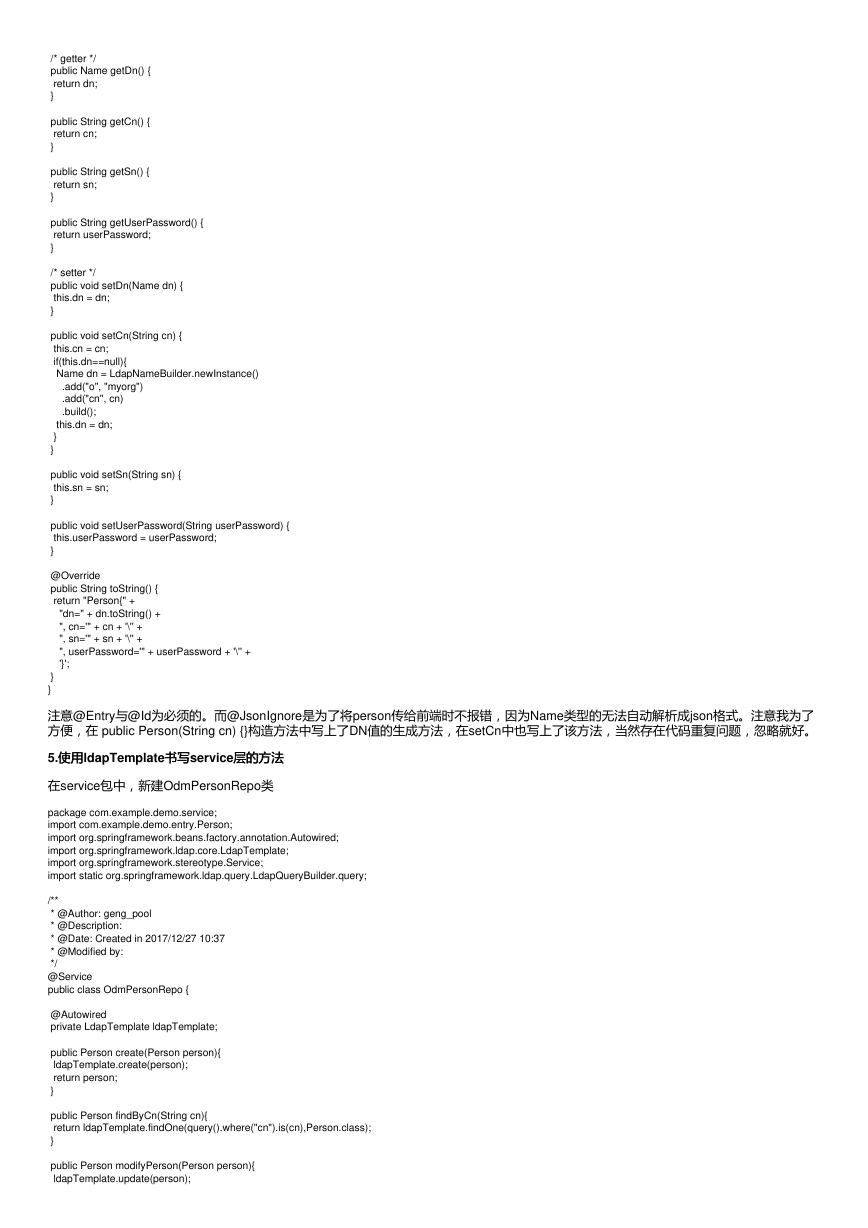
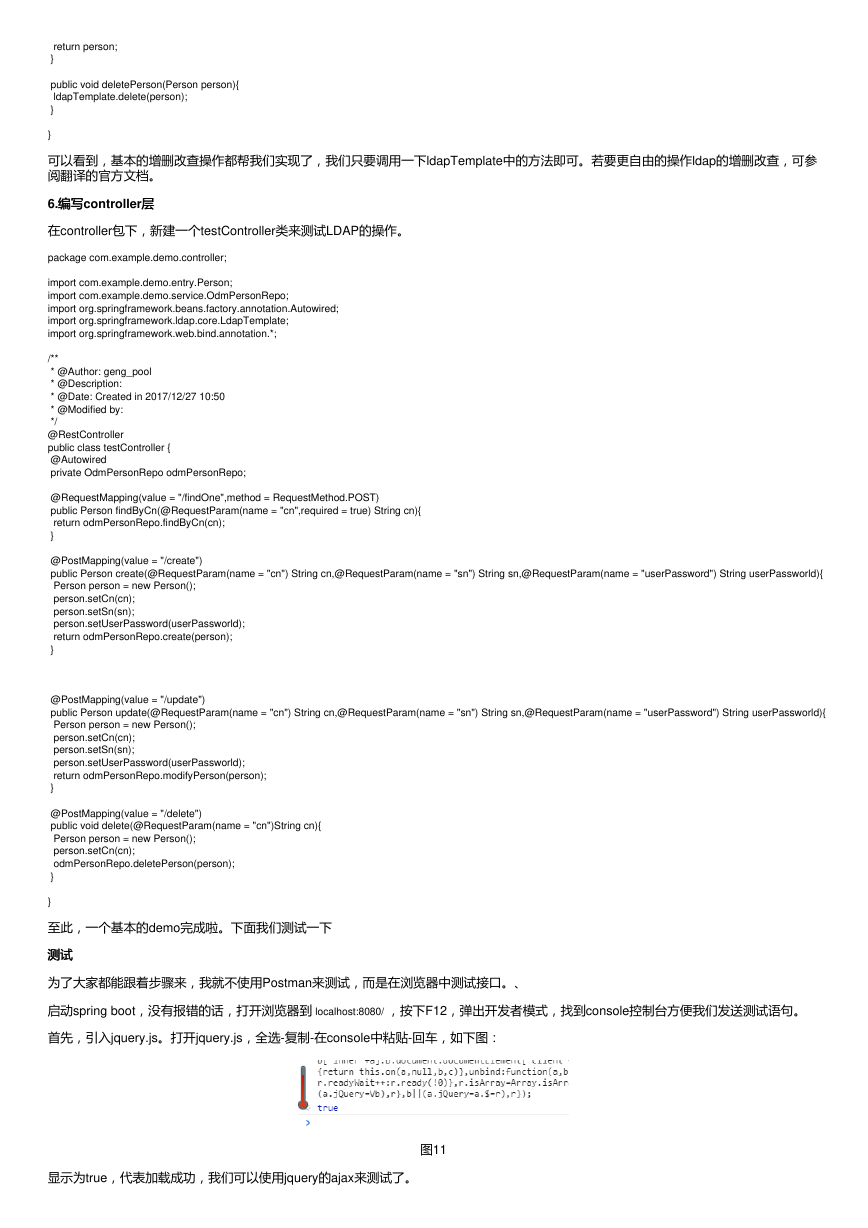
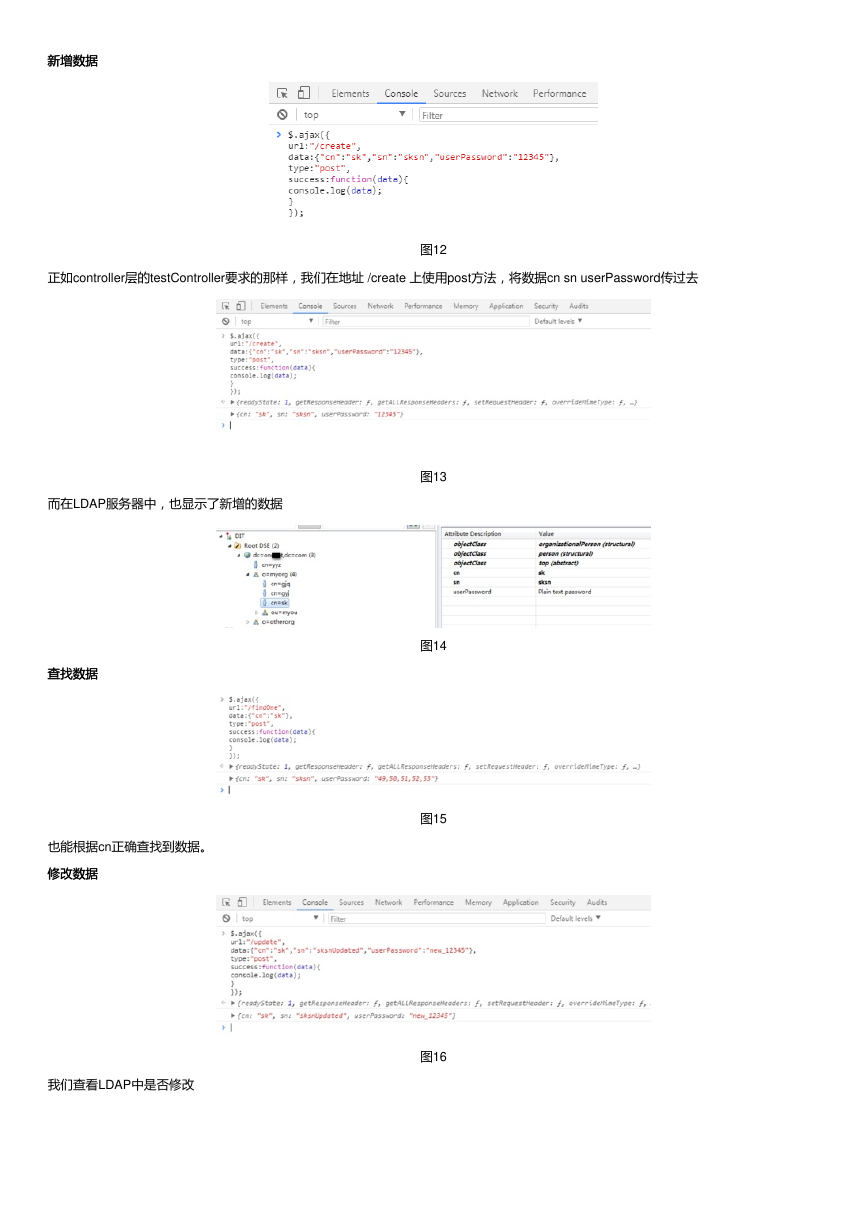
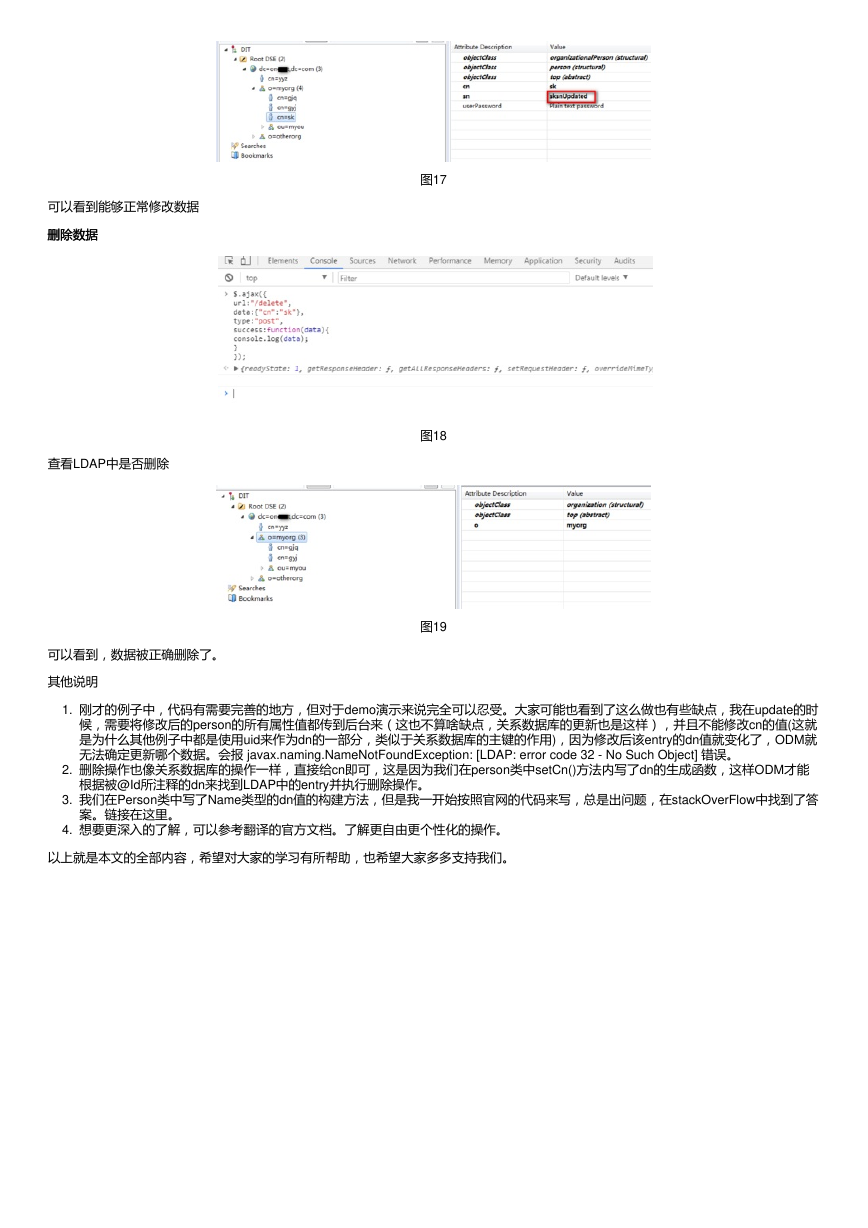








 2023年江西萍乡中考道德与法治真题及答案.doc
2023年江西萍乡中考道德与法治真题及答案.doc 2012年重庆南川中考生物真题及答案.doc
2012年重庆南川中考生物真题及答案.doc 2013年江西师范大学地理学综合及文艺理论基础考研真题.doc
2013年江西师范大学地理学综合及文艺理论基础考研真题.doc 2020年四川甘孜小升初语文真题及答案I卷.doc
2020年四川甘孜小升初语文真题及答案I卷.doc 2020年注册岩土工程师专业基础考试真题及答案.doc
2020年注册岩土工程师专业基础考试真题及答案.doc 2023-2024学年福建省厦门市九年级上学期数学月考试题及答案.doc
2023-2024学年福建省厦门市九年级上学期数学月考试题及答案.doc 2021-2022学年辽宁省沈阳市大东区九年级上学期语文期末试题及答案.doc
2021-2022学年辽宁省沈阳市大东区九年级上学期语文期末试题及答案.doc 2022-2023学年北京东城区初三第一学期物理期末试卷及答案.doc
2022-2023学年北京东城区初三第一学期物理期末试卷及答案.doc 2018上半年江西教师资格初中地理学科知识与教学能力真题及答案.doc
2018上半年江西教师资格初中地理学科知识与教学能力真题及答案.doc 2012年河北国家公务员申论考试真题及答案-省级.doc
2012年河北国家公务员申论考试真题及答案-省级.doc 2020-2021学年江苏省扬州市江都区邵樊片九年级上学期数学第一次质量检测试题及答案.doc
2020-2021学年江苏省扬州市江都区邵樊片九年级上学期数学第一次质量检测试题及答案.doc 2022下半年黑龙江教师资格证中学综合素质真题及答案.doc
2022下半年黑龙江教师资格证中学综合素质真题及答案.doc